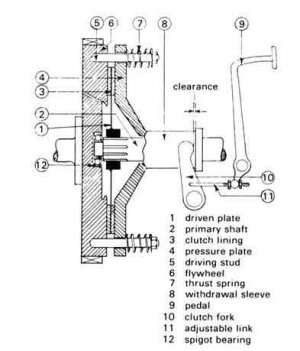Generally speaking, that diagram is a bit backwards, at least when thinking of Automotive clutches. An automotive clutch usually has a pressure plate that compresses the clutch disc between the pressure plate and the flywheel with spring pressure. The levers that release the pressure are usually activated by pushing a release , or "throwout" bearing toward the flywheel. The pressure plate is designed so that this releases the compression allowing the clutch disc to turn freely. The throwout bearing is usually activated by a fork on a fixed pivot point. That diagram would require the sleeve to be pulled away from the flywheel to release the pressure. To answer your original question, yes the release sleeve would need some sort of thrust bearing that would allow the sleeve to rotate with the clutch and transfer the release pressure from the fixed release fork to the rotating pressure plate.



